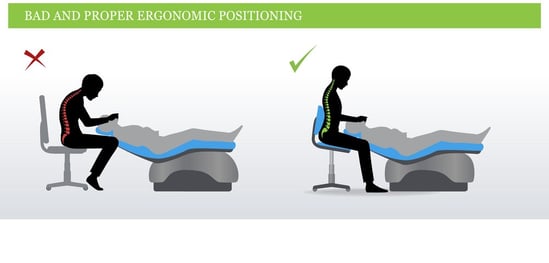Ergonomics in Dental Clinic Design
The design of a dental clinic plays a pivotal role in the comfort and efficiency experienced by both patients and dental professionals. Ergonomics, the study of people's efficiency in their working environment, is a critical consideration in this context. Ergonomic design in dental clinics is not just about selecting the right furniture; it encompasses the thoughtful arrangement of the entire clinic space, ensuring that every element contributes to a seamless and comfortable experience. This blog explores the multifaceted aspects of ergonomic design in dental clinics, emphasizing how it enhances comfort and efficiency.
Understanding Ergonomics in Dental Settings
Enhancing Comfort and Efficiency
Ergonomics in a dental clinic involves creating a workspace that adapts to the physical and psychological needs of the dental team and their patients. This includes everything from the dental chair design to the layout of the clinic. An ergonomically designed clinic can significantly reduce physical strain on the dental team, minimize the risk of work-related musculoskeletal disorders, and enhance the overall patient experience.
The Ergonomic Dental Chair: A Keystone of Clinic Design
The dental chair is the centerpiece of ergonomic consideration in a dental clinic. An ideal dental chair should provide optimal support and comfort to the patient while offering the dental professional unimpeded access to the patient's oral cavity. Features such as adjustable headrests, armrests, and chair height not only cater to patient comfort but also ensure that the dentist can maintain a healthy posture, avoiding strain during procedures.
Strategic Equipment Placement for Operational Efficiency
The placement of dental equipment is crucial in creating an efficient workflow. Equipment and tools should be within easy reach to minimize unnecessary movements. For example, placing frequently used instruments on a mobile delivery system can reduce the need to twist and turn, thereby lowering the risk of back and neck pain. Additionally, integrating technology such as intraoral cameras and digital displays within arm's reach can enhance diagnostic efficiency without compromising ergonomic principles.
Lighting and Visual Ergonomics
Proper lighting is essential in a dental clinic, not only for carrying out precise procedures but also for reducing eye strain. Adjustable and shadow-free lighting systems can significantly improve visual clarity and comfort. The strategic placement of windows to maximize natural light, supplemented by LED lighting where necessary, can create an environment that is both visually comfortable and energy-efficient.
Designing for Movement and Flow
An ergonomically designed clinic optimizes the movement and flow of both patients and staff. This includes ensuring there are clear, unobstructed pathways for easy movement, designing treatment rooms with enough space to move around comfortably, and considering the placement of essential areas such as the reception, waiting area, and treatment rooms to minimize unnecessary foot traffic.
The Role of Reception and Waiting Areas
The reception and waiting areas are the first points of contact for patients, and their design can significantly impact a patient's level of comfort and anxiety. Ergonomic considerations here include comfortable seating, a welcoming layout, and elements such as plants or artwork to create a calming atmosphere. Additionally, the reception desk should be designed to accommodate staff comfortably, with computer screens, keyboards, and telephones positioned to reduce strain.
Accessibility and Inclusivity
An ergonomic dental clinic design also means ensuring accessibility for all patients, including those with disabilities. This involves considering wheelchair access, adjustable furniture, and equipment that caters to a diverse range of patient needs.
Conclusion
Ergonomics is an integral part of dental clinic design, emphasizing the health, comfort, and efficiency of both patients and dental professionals. By incorporating ergonomic principles, from the dental chair to the layout of the clinic, dental practices can create an environment that fosters well-being and productivity. An investment in ergonomic design is not just an investment in a physical space; it's an investment in the people who use it, ensuring that they can receive and provide dental care in the most comfortable and efficient manner possible.


